Detailed Care Plan for Heather Cook: Nursing Interventions
VerifiedAdded on 2020/10/22
|11
|3440
|309
Report
AI Summary
This document presents a detailed care plan for Mrs. Heather Cook, addressing multiple nursing diagnostic statements. The plan begins with an overview of Mrs. Cook's condition, including her reported pain level of 7/10 and reliance on community nurses. The care plan is structured around four primary nursing diagnoses: acute pain, impaired skin integrity, impaired urinary elimination, and impaired physical mobility. Each diagnosis includes expected outcomes and a series of nursing interventions with rationales. For acute pain, interventions focus on rest, positional changes, assistive devices, and monitoring urinary function. Impaired skin integrity interventions emphasize cushioning, skin dryness, regular assessments, and wound care. Interventions for impaired urinary elimination focus on maintaining bladder pH, encouraging frequent voiding, increasing fluid intake, and limiting catheter usage. Finally, the plan addresses impaired physical mobility through exercises, specialized beds, limb alignment, and medication. The document concludes with a handover of care using the ISOBAR approach, providing essential information for the next shift nurse. References are included to support the interventions and rationales.
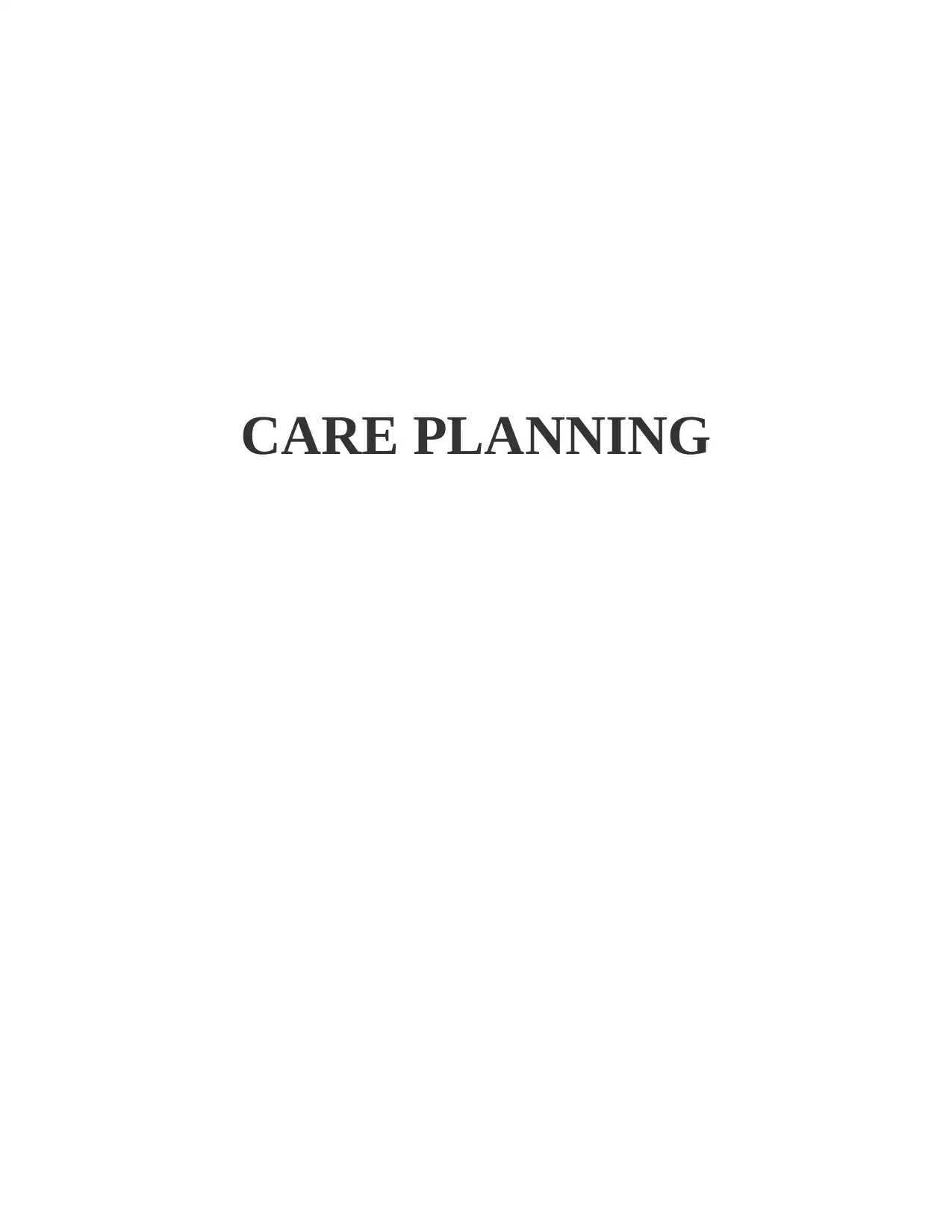
CARE PLANNING
Paraphrase This Document
Need a fresh take? Get an instant paraphrase of this document with our AI Paraphraser
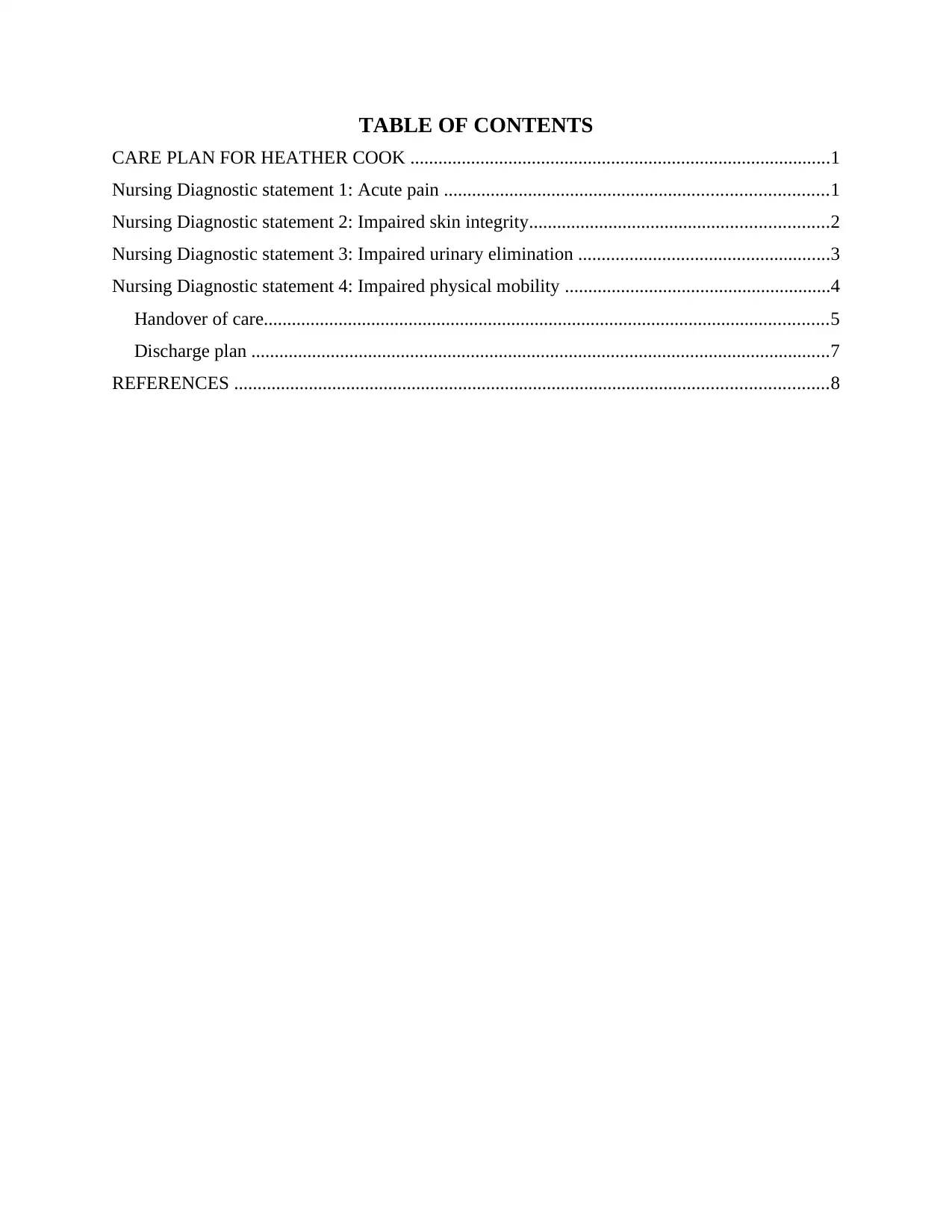
TABLE OF CONTENTS
CARE PLAN FOR HEATHER COOK ..........................................................................................1
Nursing Diagnostic statement 1: Acute pain ..................................................................................1
Nursing Diagnostic statement 2: Impaired skin integrity................................................................2
Nursing Diagnostic statement 3: Impaired urinary elimination ......................................................3
Nursing Diagnostic statement 4: Impaired physical mobility .........................................................4
Handover of care.........................................................................................................................5
Discharge plan ............................................................................................................................7
REFERENCES ...............................................................................................................................8
CARE PLAN FOR HEATHER COOK ..........................................................................................1
Nursing Diagnostic statement 1: Acute pain ..................................................................................1
Nursing Diagnostic statement 2: Impaired skin integrity................................................................2
Nursing Diagnostic statement 3: Impaired urinary elimination ......................................................3
Nursing Diagnostic statement 4: Impaired physical mobility .........................................................4
Handover of care.........................................................................................................................5
Discharge plan ............................................................................................................................7
REFERENCES ...............................................................................................................................8
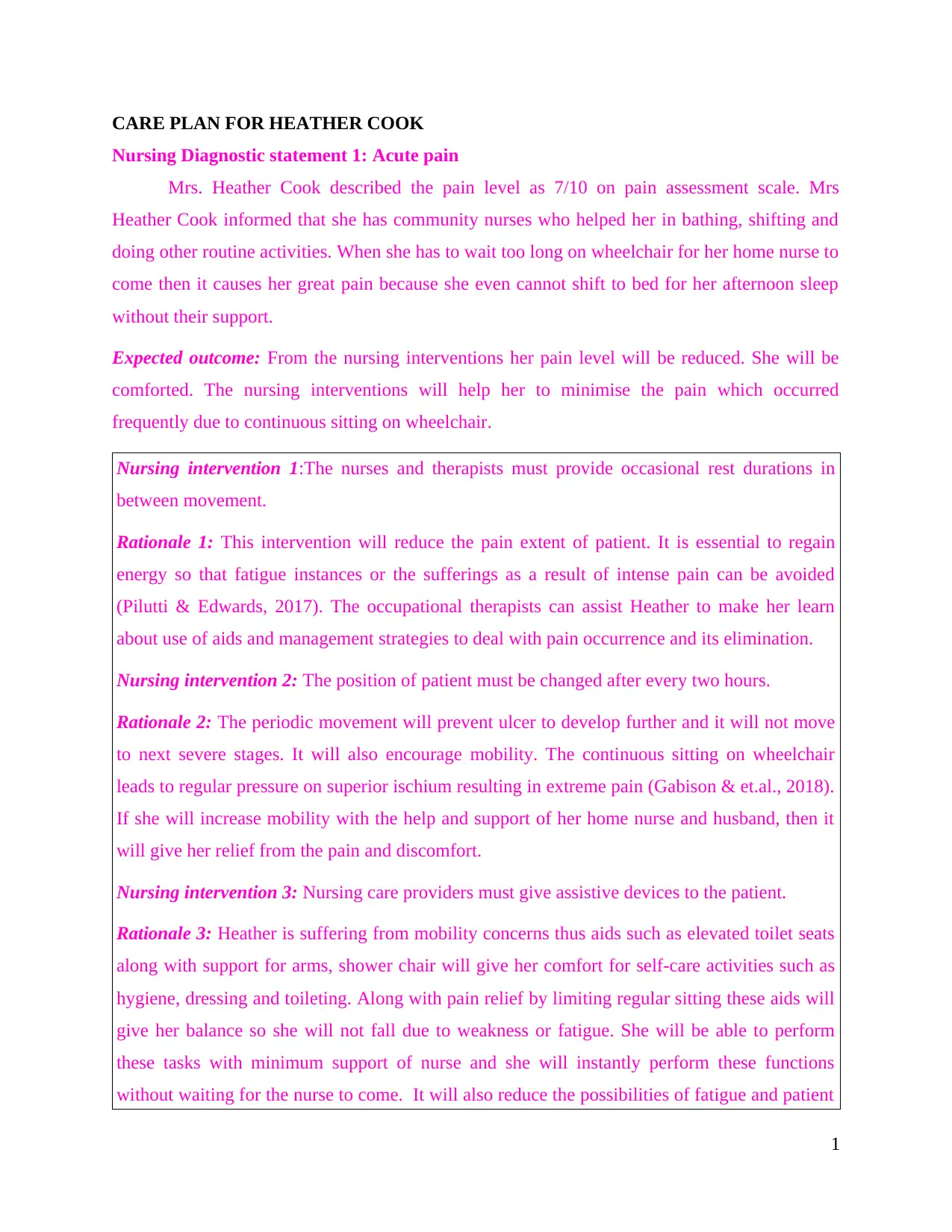
CARE PLAN FOR HEATHER COOK
Nursing Diagnostic statement 1: Acute pain
Mrs. Heather Cook described the pain level as 7/10 on pain assessment scale. Mrs
Heather Cook informed that she has community nurses who helped her in bathing, shifting and
doing other routine activities. When she has to wait too long on wheelchair for her home nurse to
come then it causes her great pain because she even cannot shift to bed for her afternoon sleep
without their support.
Expected outcome: From the nursing interventions her pain level will be reduced. She will be
comforted. The nursing interventions will help her to minimise the pain which occurred
frequently due to continuous sitting on wheelchair.
Nursing intervention 1:The nurses and therapists must provide occasional rest durations in
between movement.
Rationale 1: This intervention will reduce the pain extent of patient. It is essential to regain
energy so that fatigue instances or the sufferings as a result of intense pain can be avoided
(Pilutti & Edwards, 2017). The occupational therapists can assist Heather to make her learn
about use of aids and management strategies to deal with pain occurrence and its elimination.
Nursing intervention 2: The position of patient must be changed after every two hours.
Rationale 2: The periodic movement will prevent ulcer to develop further and it will not move
to next severe stages. It will also encourage mobility. The continuous sitting on wheelchair
leads to regular pressure on superior ischium resulting in extreme pain (Gabison & et.al., 2018).
If she will increase mobility with the help and support of her home nurse and husband, then it
will give her relief from the pain and discomfort.
Nursing intervention 3: Nursing care providers must give assistive devices to the patient.
Rationale 3: Heather is suffering from mobility concerns thus aids such as elevated toilet seats
along with support for arms, shower chair will give her comfort for self-care activities such as
hygiene, dressing and toileting. Along with pain relief by limiting regular sitting these aids will
give her balance so she will not fall due to weakness or fatigue. She will be able to perform
these tasks with minimum support of nurse and she will instantly perform these functions
without waiting for the nurse to come. It will also reduce the possibilities of fatigue and patient
1
Nursing Diagnostic statement 1: Acute pain
Mrs. Heather Cook described the pain level as 7/10 on pain assessment scale. Mrs
Heather Cook informed that she has community nurses who helped her in bathing, shifting and
doing other routine activities. When she has to wait too long on wheelchair for her home nurse to
come then it causes her great pain because she even cannot shift to bed for her afternoon sleep
without their support.
Expected outcome: From the nursing interventions her pain level will be reduced. She will be
comforted. The nursing interventions will help her to minimise the pain which occurred
frequently due to continuous sitting on wheelchair.
Nursing intervention 1:The nurses and therapists must provide occasional rest durations in
between movement.
Rationale 1: This intervention will reduce the pain extent of patient. It is essential to regain
energy so that fatigue instances or the sufferings as a result of intense pain can be avoided
(Pilutti & Edwards, 2017). The occupational therapists can assist Heather to make her learn
about use of aids and management strategies to deal with pain occurrence and its elimination.
Nursing intervention 2: The position of patient must be changed after every two hours.
Rationale 2: The periodic movement will prevent ulcer to develop further and it will not move
to next severe stages. It will also encourage mobility. The continuous sitting on wheelchair
leads to regular pressure on superior ischium resulting in extreme pain (Gabison & et.al., 2018).
If she will increase mobility with the help and support of her home nurse and husband, then it
will give her relief from the pain and discomfort.
Nursing intervention 3: Nursing care providers must give assistive devices to the patient.
Rationale 3: Heather is suffering from mobility concerns thus aids such as elevated toilet seats
along with support for arms, shower chair will give her comfort for self-care activities such as
hygiene, dressing and toileting. Along with pain relief by limiting regular sitting these aids will
give her balance so she will not fall due to weakness or fatigue. She will be able to perform
these tasks with minimum support of nurse and she will instantly perform these functions
without waiting for the nurse to come. It will also reduce the possibilities of fatigue and patient
1
⊘ This is a preview!⊘
Do you want full access?
Subscribe today to unlock all pages.

Trusted by 1+ million students worldwide
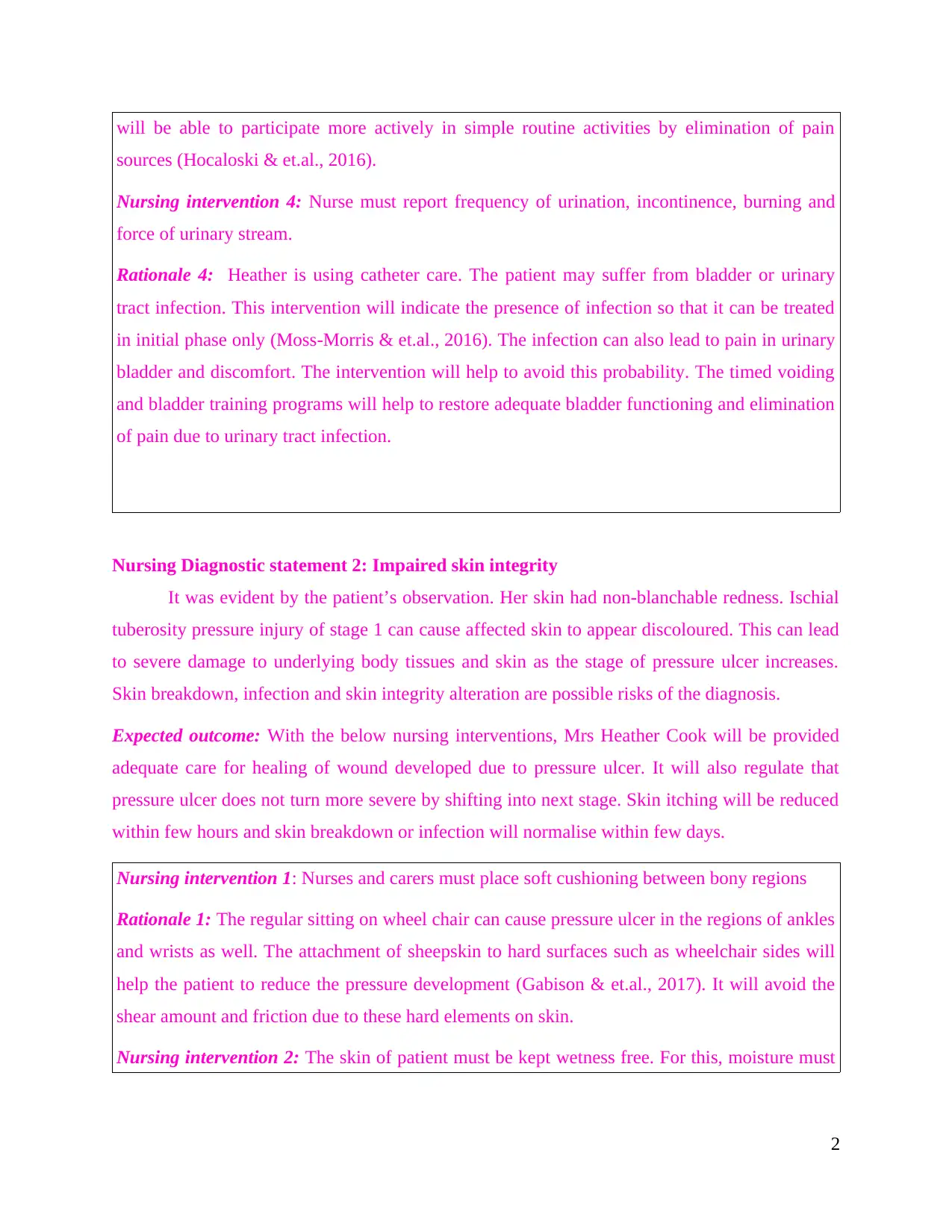
will be able to participate more actively in simple routine activities by elimination of pain
sources (Hocaloski & et.al., 2016).
Nursing intervention 4: Nurse must report frequency of urination, incontinence, burning and
force of urinary stream.
Rationale 4: Heather is using catheter care. The patient may suffer from bladder or urinary
tract infection. This intervention will indicate the presence of infection so that it can be treated
in initial phase only (Moss-Morris & et.al., 2016). The infection can also lead to pain in urinary
bladder and discomfort. The intervention will help to avoid this probability. The timed voiding
and bladder training programs will help to restore adequate bladder functioning and elimination
of pain due to urinary tract infection.
Nursing Diagnostic statement 2: Impaired skin integrity
It was evident by the patient’s observation. Her skin had non-blanchable redness. Ischial
tuberosity pressure injury of stage 1 can cause affected skin to appear discoloured. This can lead
to severe damage to underlying body tissues and skin as the stage of pressure ulcer increases.
Skin breakdown, infection and skin integrity alteration are possible risks of the diagnosis.
Expected outcome: With the below nursing interventions, Mrs Heather Cook will be provided
adequate care for healing of wound developed due to pressure ulcer. It will also regulate that
pressure ulcer does not turn more severe by shifting into next stage. Skin itching will be reduced
within few hours and skin breakdown or infection will normalise within few days.
Nursing intervention 1: Nurses and carers must place soft cushioning between bony regions
Rationale 1: The regular sitting on wheel chair can cause pressure ulcer in the regions of ankles
and wrists as well. The attachment of sheepskin to hard surfaces such as wheelchair sides will
help the patient to reduce the pressure development (Gabison & et.al., 2017). It will avoid the
shear amount and friction due to these hard elements on skin.
Nursing intervention 2: The skin of patient must be kept wetness free. For this, moisture must
2
sources (Hocaloski & et.al., 2016).
Nursing intervention 4: Nurse must report frequency of urination, incontinence, burning and
force of urinary stream.
Rationale 4: Heather is using catheter care. The patient may suffer from bladder or urinary
tract infection. This intervention will indicate the presence of infection so that it can be treated
in initial phase only (Moss-Morris & et.al., 2016). The infection can also lead to pain in urinary
bladder and discomfort. The intervention will help to avoid this probability. The timed voiding
and bladder training programs will help to restore adequate bladder functioning and elimination
of pain due to urinary tract infection.
Nursing Diagnostic statement 2: Impaired skin integrity
It was evident by the patient’s observation. Her skin had non-blanchable redness. Ischial
tuberosity pressure injury of stage 1 can cause affected skin to appear discoloured. This can lead
to severe damage to underlying body tissues and skin as the stage of pressure ulcer increases.
Skin breakdown, infection and skin integrity alteration are possible risks of the diagnosis.
Expected outcome: With the below nursing interventions, Mrs Heather Cook will be provided
adequate care for healing of wound developed due to pressure ulcer. It will also regulate that
pressure ulcer does not turn more severe by shifting into next stage. Skin itching will be reduced
within few hours and skin breakdown or infection will normalise within few days.
Nursing intervention 1: Nurses and carers must place soft cushioning between bony regions
Rationale 1: The regular sitting on wheel chair can cause pressure ulcer in the regions of ankles
and wrists as well. The attachment of sheepskin to hard surfaces such as wheelchair sides will
help the patient to reduce the pressure development (Gabison & et.al., 2017). It will avoid the
shear amount and friction due to these hard elements on skin.
Nursing intervention 2: The skin of patient must be kept wetness free. For this, moisture must
2
Paraphrase This Document
Need a fresh take? Get an instant paraphrase of this document with our AI Paraphraser
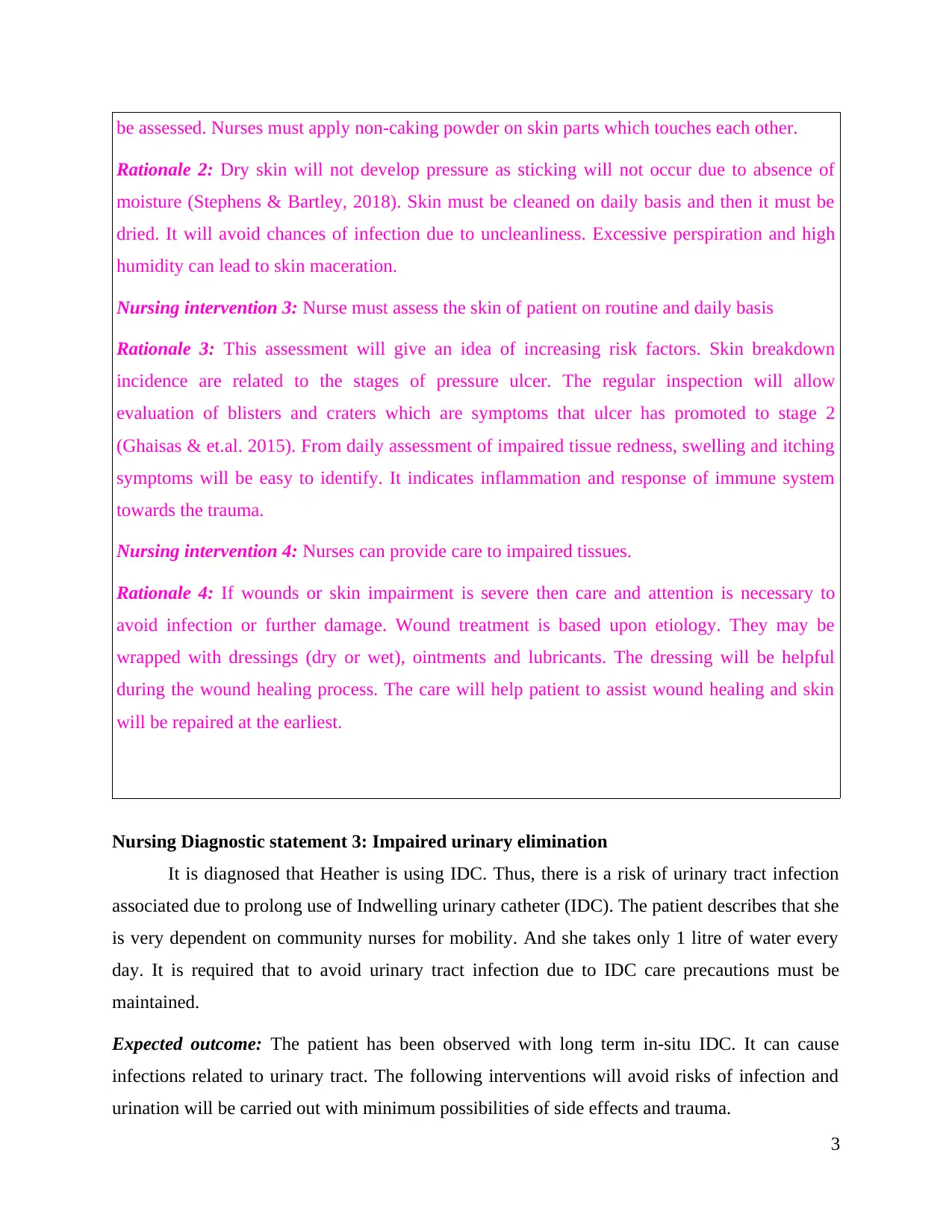
be assessed. Nurses must apply non-caking powder on skin parts which touches each other.
Rationale 2: Dry skin will not develop pressure as sticking will not occur due to absence of
moisture (Stephens & Bartley, 2018). Skin must be cleaned on daily basis and then it must be
dried. It will avoid chances of infection due to uncleanliness. Excessive perspiration and high
humidity can lead to skin maceration.
Nursing intervention 3: Nurse must assess the skin of patient on routine and daily basis
Rationale 3: This assessment will give an idea of increasing risk factors. Skin breakdown
incidence are related to the stages of pressure ulcer. The regular inspection will allow
evaluation of blisters and craters which are symptoms that ulcer has promoted to stage 2
(Ghaisas & et.al. 2015). From daily assessment of impaired tissue redness, swelling and itching
symptoms will be easy to identify. It indicates inflammation and response of immune system
towards the trauma.
Nursing intervention 4: Nurses can provide care to impaired tissues.
Rationale 4: If wounds or skin impairment is severe then care and attention is necessary to
avoid infection or further damage. Wound treatment is based upon etiology. They may be
wrapped with dressings (dry or wet), ointments and lubricants. The dressing will be helpful
during the wound healing process. The care will help patient to assist wound healing and skin
will be repaired at the earliest.
Nursing Diagnostic statement 3: Impaired urinary elimination
It is diagnosed that Heather is using IDC. Thus, there is a risk of urinary tract infection
associated due to prolong use of Indwelling urinary catheter (IDC). The patient describes that she
is very dependent on community nurses for mobility. And she takes only 1 litre of water every
day. It is required that to avoid urinary tract infection due to IDC care precautions must be
maintained.
Expected outcome: The patient has been observed with long term in-situ IDC. It can cause
infections related to urinary tract. The following interventions will avoid risks of infection and
urination will be carried out with minimum possibilities of side effects and trauma.
3
Rationale 2: Dry skin will not develop pressure as sticking will not occur due to absence of
moisture (Stephens & Bartley, 2018). Skin must be cleaned on daily basis and then it must be
dried. It will avoid chances of infection due to uncleanliness. Excessive perspiration and high
humidity can lead to skin maceration.
Nursing intervention 3: Nurse must assess the skin of patient on routine and daily basis
Rationale 3: This assessment will give an idea of increasing risk factors. Skin breakdown
incidence are related to the stages of pressure ulcer. The regular inspection will allow
evaluation of blisters and craters which are symptoms that ulcer has promoted to stage 2
(Ghaisas & et.al. 2015). From daily assessment of impaired tissue redness, swelling and itching
symptoms will be easy to identify. It indicates inflammation and response of immune system
towards the trauma.
Nursing intervention 4: Nurses can provide care to impaired tissues.
Rationale 4: If wounds or skin impairment is severe then care and attention is necessary to
avoid infection or further damage. Wound treatment is based upon etiology. They may be
wrapped with dressings (dry or wet), ointments and lubricants. The dressing will be helpful
during the wound healing process. The care will help patient to assist wound healing and skin
will be repaired at the earliest.
Nursing Diagnostic statement 3: Impaired urinary elimination
It is diagnosed that Heather is using IDC. Thus, there is a risk of urinary tract infection
associated due to prolong use of Indwelling urinary catheter (IDC). The patient describes that she
is very dependent on community nurses for mobility. And she takes only 1 litre of water every
day. It is required that to avoid urinary tract infection due to IDC care precautions must be
maintained.
Expected outcome: The patient has been observed with long term in-situ IDC. It can cause
infections related to urinary tract. The following interventions will avoid risks of infection and
urination will be carried out with minimum possibilities of side effects and trauma.
3
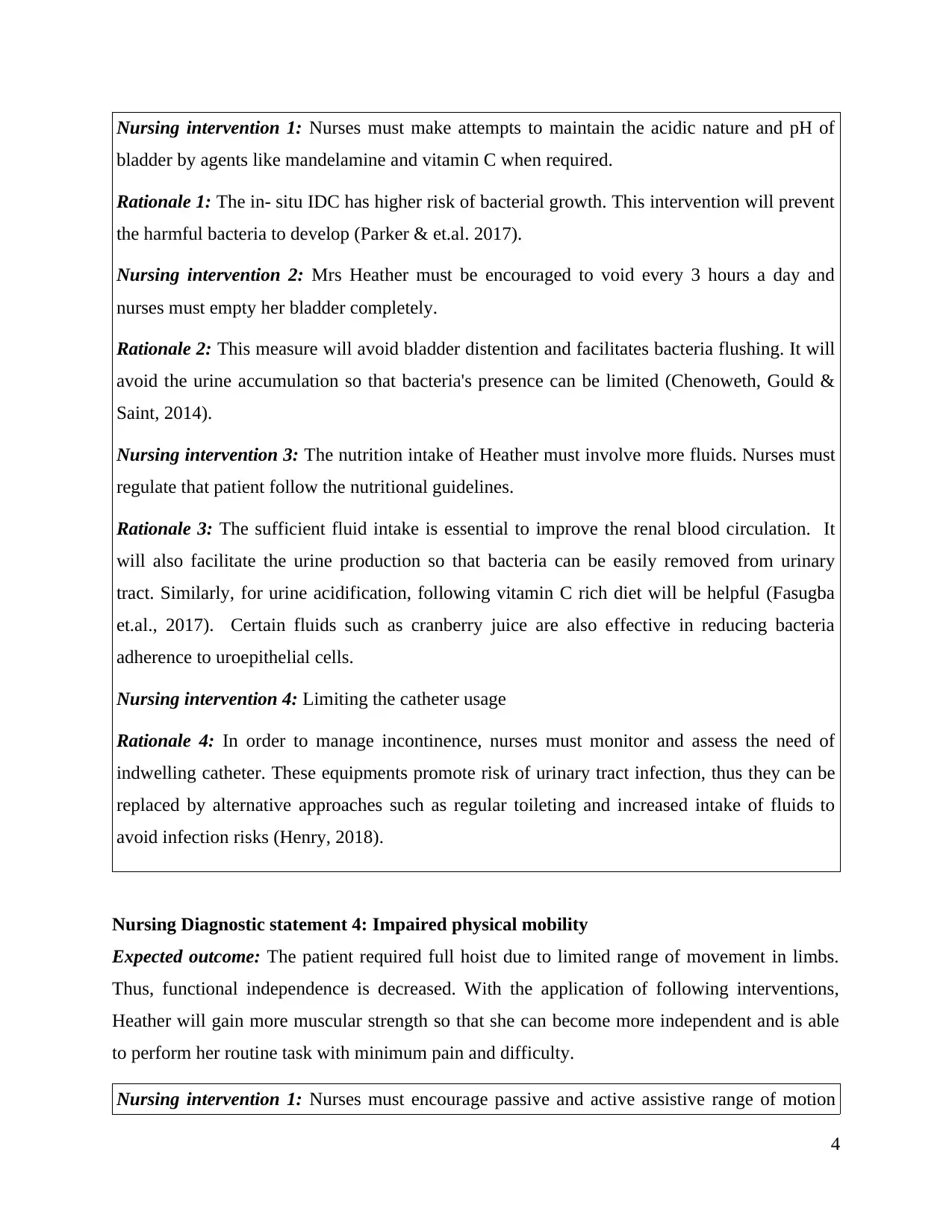
Nursing intervention 1: Nurses must make attempts to maintain the acidic nature and pH of
bladder by agents like mandelamine and vitamin C when required.
Rationale 1: The in- situ IDC has higher risk of bacterial growth. This intervention will prevent
the harmful bacteria to develop (Parker & et.al. 2017).
Nursing intervention 2: Mrs Heather must be encouraged to void every 3 hours a day and
nurses must empty her bladder completely.
Rationale 2: This measure will avoid bladder distention and facilitates bacteria flushing. It will
avoid the urine accumulation so that bacteria's presence can be limited (Chenoweth, Gould &
Saint, 2014).
Nursing intervention 3: The nutrition intake of Heather must involve more fluids. Nurses must
regulate that patient follow the nutritional guidelines.
Rationale 3: The sufficient fluid intake is essential to improve the renal blood circulation. It
will also facilitate the urine production so that bacteria can be easily removed from urinary
tract. Similarly, for urine acidification, following vitamin C rich diet will be helpful (Fasugba
et.al., 2017). Certain fluids such as cranberry juice are also effective in reducing bacteria
adherence to uroepithelial cells.
Nursing intervention 4: Limiting the catheter usage
Rationale 4: In order to manage incontinence, nurses must monitor and assess the need of
indwelling catheter. These equipments promote risk of urinary tract infection, thus they can be
replaced by alternative approaches such as regular toileting and increased intake of fluids to
avoid infection risks (Henry, 2018).
Nursing Diagnostic statement 4: Impaired physical mobility
Expected outcome: The patient required full hoist due to limited range of movement in limbs.
Thus, functional independence is decreased. With the application of following interventions,
Heather will gain more muscular strength so that she can become more independent and is able
to perform her routine task with minimum pain and difficulty.
Nursing intervention 1: Nurses must encourage passive and active assistive range of motion
4
bladder by agents like mandelamine and vitamin C when required.
Rationale 1: The in- situ IDC has higher risk of bacterial growth. This intervention will prevent
the harmful bacteria to develop (Parker & et.al. 2017).
Nursing intervention 2: Mrs Heather must be encouraged to void every 3 hours a day and
nurses must empty her bladder completely.
Rationale 2: This measure will avoid bladder distention and facilitates bacteria flushing. It will
avoid the urine accumulation so that bacteria's presence can be limited (Chenoweth, Gould &
Saint, 2014).
Nursing intervention 3: The nutrition intake of Heather must involve more fluids. Nurses must
regulate that patient follow the nutritional guidelines.
Rationale 3: The sufficient fluid intake is essential to improve the renal blood circulation. It
will also facilitate the urine production so that bacteria can be easily removed from urinary
tract. Similarly, for urine acidification, following vitamin C rich diet will be helpful (Fasugba
et.al., 2017). Certain fluids such as cranberry juice are also effective in reducing bacteria
adherence to uroepithelial cells.
Nursing intervention 4: Limiting the catheter usage
Rationale 4: In order to manage incontinence, nurses must monitor and assess the need of
indwelling catheter. These equipments promote risk of urinary tract infection, thus they can be
replaced by alternative approaches such as regular toileting and increased intake of fluids to
avoid infection risks (Henry, 2018).
Nursing Diagnostic statement 4: Impaired physical mobility
Expected outcome: The patient required full hoist due to limited range of movement in limbs.
Thus, functional independence is decreased. With the application of following interventions,
Heather will gain more muscular strength so that she can become more independent and is able
to perform her routine task with minimum pain and difficulty.
Nursing intervention 1: Nurses must encourage passive and active assistive range of motion
4
⊘ This is a preview!⊘
Do you want full access?
Subscribe today to unlock all pages.

Trusted by 1+ million students worldwide
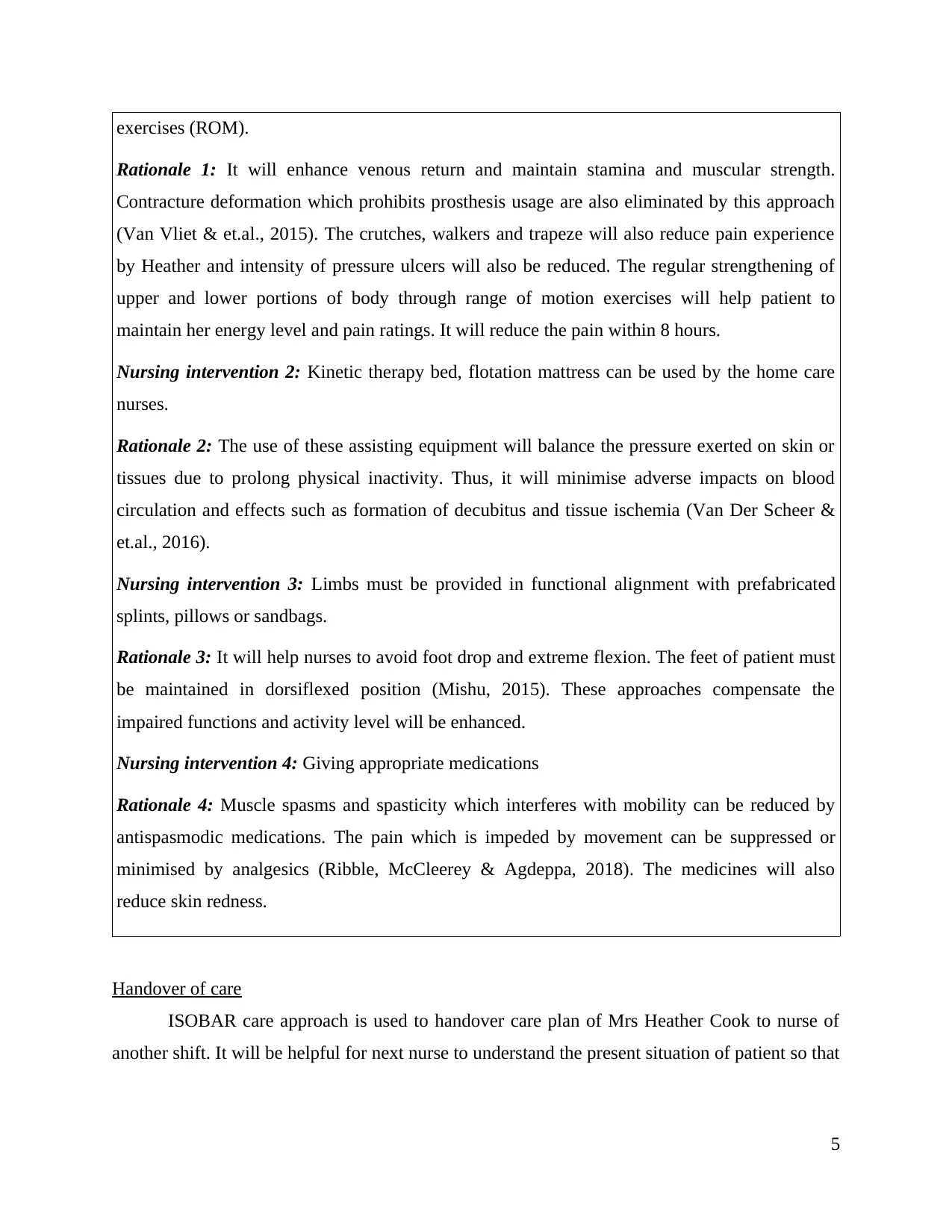
exercises (ROM).
Rationale 1: It will enhance venous return and maintain stamina and muscular strength.
Contracture deformation which prohibits prosthesis usage are also eliminated by this approach
(Van Vliet & et.al., 2015). The crutches, walkers and trapeze will also reduce pain experience
by Heather and intensity of pressure ulcers will also be reduced. The regular strengthening of
upper and lower portions of body through range of motion exercises will help patient to
maintain her energy level and pain ratings. It will reduce the pain within 8 hours.
Nursing intervention 2: Kinetic therapy bed, flotation mattress can be used by the home care
nurses.
Rationale 2: The use of these assisting equipment will balance the pressure exerted on skin or
tissues due to prolong physical inactivity. Thus, it will minimise adverse impacts on blood
circulation and effects such as formation of decubitus and tissue ischemia (Van Der Scheer &
et.al., 2016).
Nursing intervention 3: Limbs must be provided in functional alignment with prefabricated
splints, pillows or sandbags.
Rationale 3: It will help nurses to avoid foot drop and extreme flexion. The feet of patient must
be maintained in dorsiflexed position (Mishu, 2015). These approaches compensate the
impaired functions and activity level will be enhanced.
Nursing intervention 4: Giving appropriate medications
Rationale 4: Muscle spasms and spasticity which interferes with mobility can be reduced by
antispasmodic medications. The pain which is impeded by movement can be suppressed or
minimised by analgesics (Ribble, McCleerey & Agdeppa, 2018). The medicines will also
reduce skin redness.
Handover of care
ISOBAR care approach is used to handover care plan of Mrs Heather Cook to nurse of
another shift. It will be helpful for next nurse to understand the present situation of patient so that
5
Rationale 1: It will enhance venous return and maintain stamina and muscular strength.
Contracture deformation which prohibits prosthesis usage are also eliminated by this approach
(Van Vliet & et.al., 2015). The crutches, walkers and trapeze will also reduce pain experience
by Heather and intensity of pressure ulcers will also be reduced. The regular strengthening of
upper and lower portions of body through range of motion exercises will help patient to
maintain her energy level and pain ratings. It will reduce the pain within 8 hours.
Nursing intervention 2: Kinetic therapy bed, flotation mattress can be used by the home care
nurses.
Rationale 2: The use of these assisting equipment will balance the pressure exerted on skin or
tissues due to prolong physical inactivity. Thus, it will minimise adverse impacts on blood
circulation and effects such as formation of decubitus and tissue ischemia (Van Der Scheer &
et.al., 2016).
Nursing intervention 3: Limbs must be provided in functional alignment with prefabricated
splints, pillows or sandbags.
Rationale 3: It will help nurses to avoid foot drop and extreme flexion. The feet of patient must
be maintained in dorsiflexed position (Mishu, 2015). These approaches compensate the
impaired functions and activity level will be enhanced.
Nursing intervention 4: Giving appropriate medications
Rationale 4: Muscle spasms and spasticity which interferes with mobility can be reduced by
antispasmodic medications. The pain which is impeded by movement can be suppressed or
minimised by analgesics (Ribble, McCleerey & Agdeppa, 2018). The medicines will also
reduce skin redness.
Handover of care
ISOBAR care approach is used to handover care plan of Mrs Heather Cook to nurse of
another shift. It will be helpful for next nurse to understand the present situation of patient so that
5
Paraphrase This Document
Need a fresh take? Get an instant paraphrase of this document with our AI Paraphraser
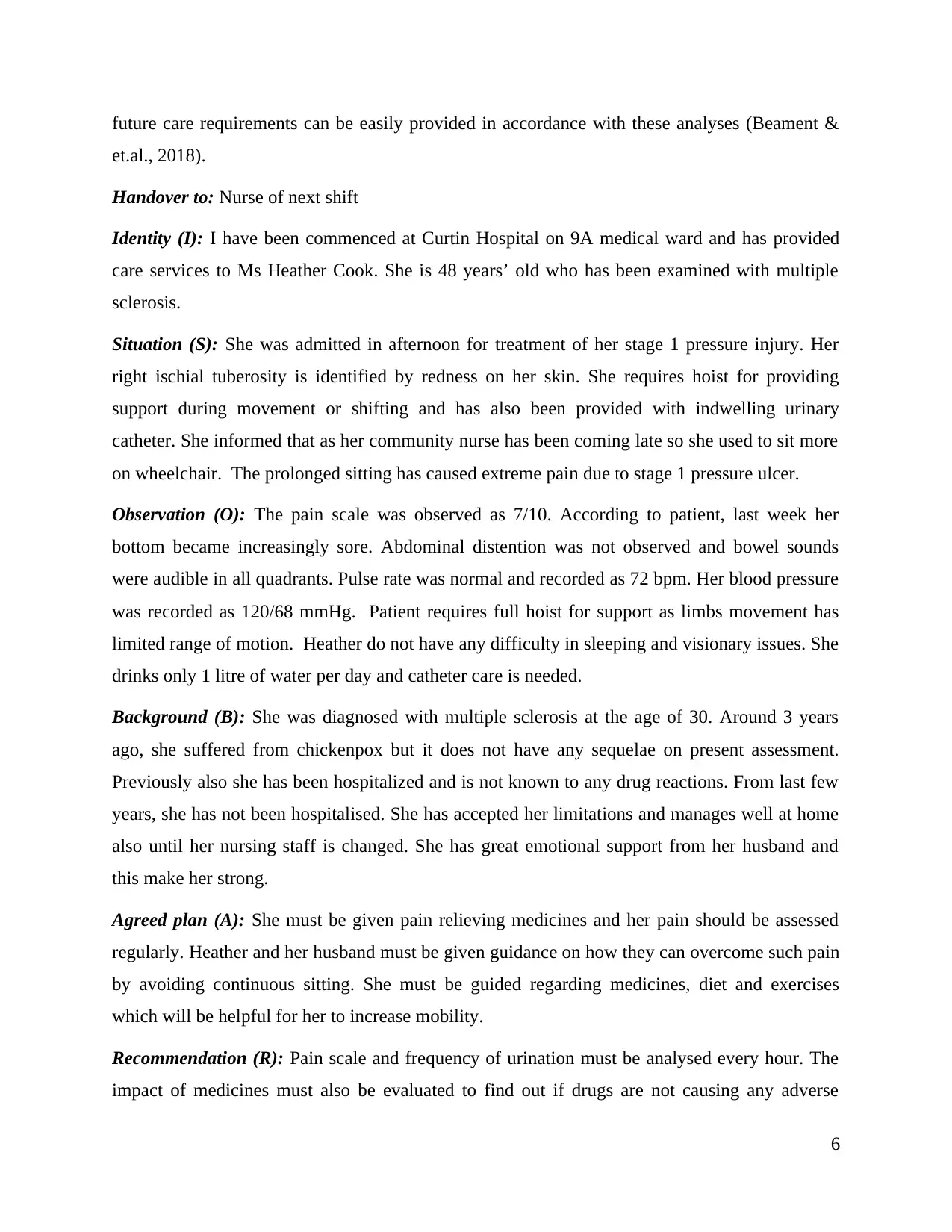
future care requirements can be easily provided in accordance with these analyses (Beament &
et.al., 2018).
Handover to: Nurse of next shift
Identity (I): I have been commenced at Curtin Hospital on 9A medical ward and has provided
care services to Ms Heather Cook. She is 48 years’ old who has been examined with multiple
sclerosis.
Situation (S): She was admitted in afternoon for treatment of her stage 1 pressure injury. Her
right ischial tuberosity is identified by redness on her skin. She requires hoist for providing
support during movement or shifting and has also been provided with indwelling urinary
catheter. She informed that as her community nurse has been coming late so she used to sit more
on wheelchair. The prolonged sitting has caused extreme pain due to stage 1 pressure ulcer.
Observation (O): The pain scale was observed as 7/10. According to patient, last week her
bottom became increasingly sore. Abdominal distention was not observed and bowel sounds
were audible in all quadrants. Pulse rate was normal and recorded as 72 bpm. Her blood pressure
was recorded as 120/68 mmHg. Patient requires full hoist for support as limbs movement has
limited range of motion. Heather do not have any difficulty in sleeping and visionary issues. She
drinks only 1 litre of water per day and catheter care is needed.
Background (B): She was diagnosed with multiple sclerosis at the age of 30. Around 3 years
ago, she suffered from chickenpox but it does not have any sequelae on present assessment.
Previously also she has been hospitalized and is not known to any drug reactions. From last few
years, she has not been hospitalised. She has accepted her limitations and manages well at home
also until her nursing staff is changed. She has great emotional support from her husband and
this make her strong.
Agreed plan (A): She must be given pain relieving medicines and her pain should be assessed
regularly. Heather and her husband must be given guidance on how they can overcome such pain
by avoiding continuous sitting. She must be guided regarding medicines, diet and exercises
which will be helpful for her to increase mobility.
Recommendation (R): Pain scale and frequency of urination must be analysed every hour. The
impact of medicines must also be evaluated to find out if drugs are not causing any adverse
6
et.al., 2018).
Handover to: Nurse of next shift
Identity (I): I have been commenced at Curtin Hospital on 9A medical ward and has provided
care services to Ms Heather Cook. She is 48 years’ old who has been examined with multiple
sclerosis.
Situation (S): She was admitted in afternoon for treatment of her stage 1 pressure injury. Her
right ischial tuberosity is identified by redness on her skin. She requires hoist for providing
support during movement or shifting and has also been provided with indwelling urinary
catheter. She informed that as her community nurse has been coming late so she used to sit more
on wheelchair. The prolonged sitting has caused extreme pain due to stage 1 pressure ulcer.
Observation (O): The pain scale was observed as 7/10. According to patient, last week her
bottom became increasingly sore. Abdominal distention was not observed and bowel sounds
were audible in all quadrants. Pulse rate was normal and recorded as 72 bpm. Her blood pressure
was recorded as 120/68 mmHg. Patient requires full hoist for support as limbs movement has
limited range of motion. Heather do not have any difficulty in sleeping and visionary issues. She
drinks only 1 litre of water per day and catheter care is needed.
Background (B): She was diagnosed with multiple sclerosis at the age of 30. Around 3 years
ago, she suffered from chickenpox but it does not have any sequelae on present assessment.
Previously also she has been hospitalized and is not known to any drug reactions. From last few
years, she has not been hospitalised. She has accepted her limitations and manages well at home
also until her nursing staff is changed. She has great emotional support from her husband and
this make her strong.
Agreed plan (A): She must be given pain relieving medicines and her pain should be assessed
regularly. Heather and her husband must be given guidance on how they can overcome such pain
by avoiding continuous sitting. She must be guided regarding medicines, diet and exercises
which will be helpful for her to increase mobility.
Recommendation (R): Pain scale and frequency of urination must be analysed every hour. The
impact of medicines must also be evaluated to find out if drugs are not causing any adverse
6
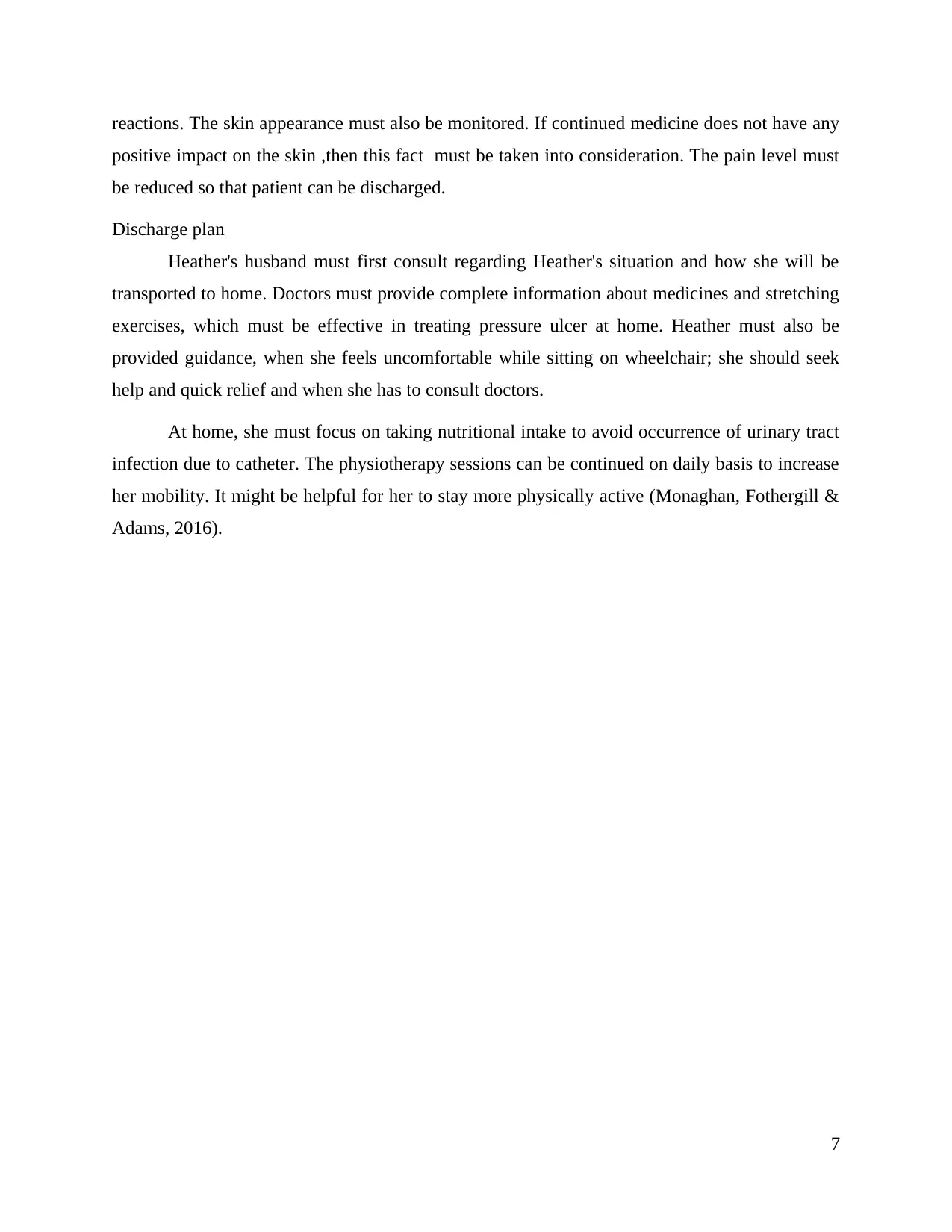
reactions. The skin appearance must also be monitored. If continued medicine does not have any
positive impact on the skin ,then this fact must be taken into consideration. The pain level must
be reduced so that patient can be discharged.
Discharge plan
Heather's husband must first consult regarding Heather's situation and how she will be
transported to home. Doctors must provide complete information about medicines and stretching
exercises, which must be effective in treating pressure ulcer at home. Heather must also be
provided guidance, when she feels uncomfortable while sitting on wheelchair; she should seek
help and quick relief and when she has to consult doctors.
At home, she must focus on taking nutritional intake to avoid occurrence of urinary tract
infection due to catheter. The physiotherapy sessions can be continued on daily basis to increase
her mobility. It might be helpful for her to stay more physically active (Monaghan, Fothergill &
Adams, 2016).
7
positive impact on the skin ,then this fact must be taken into consideration. The pain level must
be reduced so that patient can be discharged.
Discharge plan
Heather's husband must first consult regarding Heather's situation and how she will be
transported to home. Doctors must provide complete information about medicines and stretching
exercises, which must be effective in treating pressure ulcer at home. Heather must also be
provided guidance, when she feels uncomfortable while sitting on wheelchair; she should seek
help and quick relief and when she has to consult doctors.
At home, she must focus on taking nutritional intake to avoid occurrence of urinary tract
infection due to catheter. The physiotherapy sessions can be continued on daily basis to increase
her mobility. It might be helpful for her to stay more physically active (Monaghan, Fothergill &
Adams, 2016).
7
⊘ This is a preview!⊘
Do you want full access?
Subscribe today to unlock all pages.

Trusted by 1+ million students worldwide
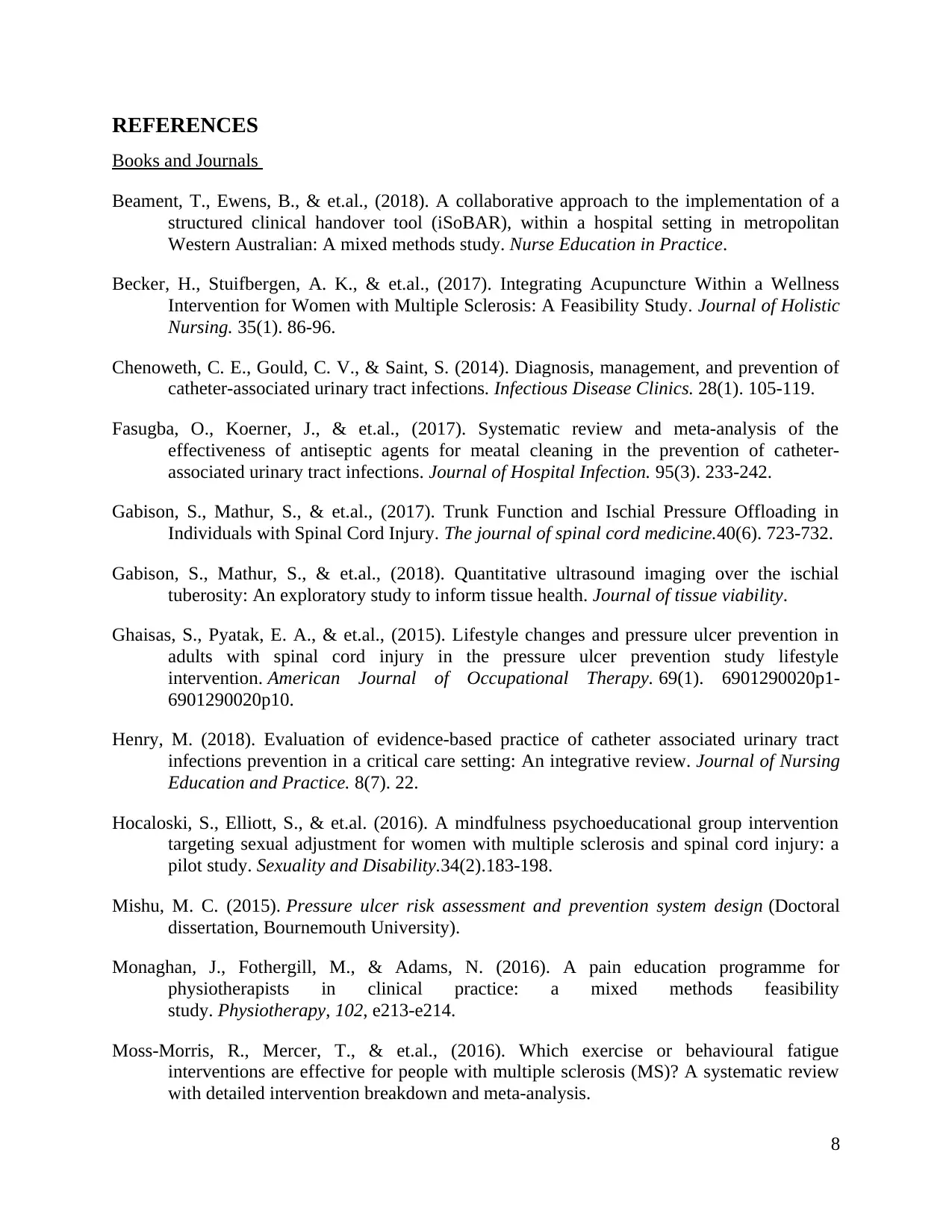
REFERENCES
Books and Journals
Beament, T., Ewens, B., & et.al., (2018). A collaborative approach to the implementation of a
structured clinical handover tool (iSoBAR), within a hospital setting in metropolitan
Western Australian: A mixed methods study. Nurse Education in Practice.
Becker, H., Stuifbergen, A. K., & et.al., (2017). Integrating Acupuncture Within a Wellness
Intervention for Women with Multiple Sclerosis: A Feasibility Study. Journal of Holistic
Nursing. 35(1). 86-96.
Chenoweth, C. E., Gould, C. V., & Saint, S. (2014). Diagnosis, management, and prevention of
catheter-associated urinary tract infections. Infectious Disease Clinics. 28(1). 105-119.
Fasugba, O., Koerner, J., & et.al., (2017). Systematic review and meta-analysis of the
effectiveness of antiseptic agents for meatal cleaning in the prevention of catheter-
associated urinary tract infections. Journal of Hospital Infection. 95(3). 233-242.
Gabison, S., Mathur, S., & et.al., (2017). Trunk Function and Ischial Pressure Offloading in
Individuals with Spinal Cord Injury. The journal of spinal cord medicine.40(6). 723-732.
Gabison, S., Mathur, S., & et.al., (2018). Quantitative ultrasound imaging over the ischial
tuberosity: An exploratory study to inform tissue health. Journal of tissue viability.
Ghaisas, S., Pyatak, E. A., & et.al., (2015). Lifestyle changes and pressure ulcer prevention in
adults with spinal cord injury in the pressure ulcer prevention study lifestyle
intervention. American Journal of Occupational Therapy. 69(1). 6901290020p1-
6901290020p10.
Henry, M. (2018). Evaluation of evidence-based practice of catheter associated urinary tract
infections prevention in a critical care setting: An integrative review. Journal of Nursing
Education and Practice. 8(7). 22.
Hocaloski, S., Elliott, S., & et.al. (2016). A mindfulness psychoeducational group intervention
targeting sexual adjustment for women with multiple sclerosis and spinal cord injury: a
pilot study. Sexuality and Disability.34(2).183-198.
Mishu, M. C. (2015). Pressure ulcer risk assessment and prevention system design (Doctoral
dissertation, Bournemouth University).
Monaghan, J., Fothergill, M., & Adams, N. (2016). A pain education programme for
physiotherapists in clinical practice: a mixed methods feasibility
study. Physiotherapy, 102, e213-e214.
Moss-Morris, R., Mercer, T., & et.al., (2016). Which exercise or behavioural fatigue
interventions are effective for people with multiple sclerosis (MS)? A systematic review
with detailed intervention breakdown and meta-analysis.
8
Books and Journals
Beament, T., Ewens, B., & et.al., (2018). A collaborative approach to the implementation of a
structured clinical handover tool (iSoBAR), within a hospital setting in metropolitan
Western Australian: A mixed methods study. Nurse Education in Practice.
Becker, H., Stuifbergen, A. K., & et.al., (2017). Integrating Acupuncture Within a Wellness
Intervention for Women with Multiple Sclerosis: A Feasibility Study. Journal of Holistic
Nursing. 35(1). 86-96.
Chenoweth, C. E., Gould, C. V., & Saint, S. (2014). Diagnosis, management, and prevention of
catheter-associated urinary tract infections. Infectious Disease Clinics. 28(1). 105-119.
Fasugba, O., Koerner, J., & et.al., (2017). Systematic review and meta-analysis of the
effectiveness of antiseptic agents for meatal cleaning in the prevention of catheter-
associated urinary tract infections. Journal of Hospital Infection. 95(3). 233-242.
Gabison, S., Mathur, S., & et.al., (2017). Trunk Function and Ischial Pressure Offloading in
Individuals with Spinal Cord Injury. The journal of spinal cord medicine.40(6). 723-732.
Gabison, S., Mathur, S., & et.al., (2018). Quantitative ultrasound imaging over the ischial
tuberosity: An exploratory study to inform tissue health. Journal of tissue viability.
Ghaisas, S., Pyatak, E. A., & et.al., (2015). Lifestyle changes and pressure ulcer prevention in
adults with spinal cord injury in the pressure ulcer prevention study lifestyle
intervention. American Journal of Occupational Therapy. 69(1). 6901290020p1-
6901290020p10.
Henry, M. (2018). Evaluation of evidence-based practice of catheter associated urinary tract
infections prevention in a critical care setting: An integrative review. Journal of Nursing
Education and Practice. 8(7). 22.
Hocaloski, S., Elliott, S., & et.al. (2016). A mindfulness psychoeducational group intervention
targeting sexual adjustment for women with multiple sclerosis and spinal cord injury: a
pilot study. Sexuality and Disability.34(2).183-198.
Mishu, M. C. (2015). Pressure ulcer risk assessment and prevention system design (Doctoral
dissertation, Bournemouth University).
Monaghan, J., Fothergill, M., & Adams, N. (2016). A pain education programme for
physiotherapists in clinical practice: a mixed methods feasibility
study. Physiotherapy, 102, e213-e214.
Moss-Morris, R., Mercer, T., & et.al., (2016). Which exercise or behavioural fatigue
interventions are effective for people with multiple sclerosis (MS)? A systematic review
with detailed intervention breakdown and meta-analysis.
8
Paraphrase This Document
Need a fresh take? Get an instant paraphrase of this document with our AI Paraphraser
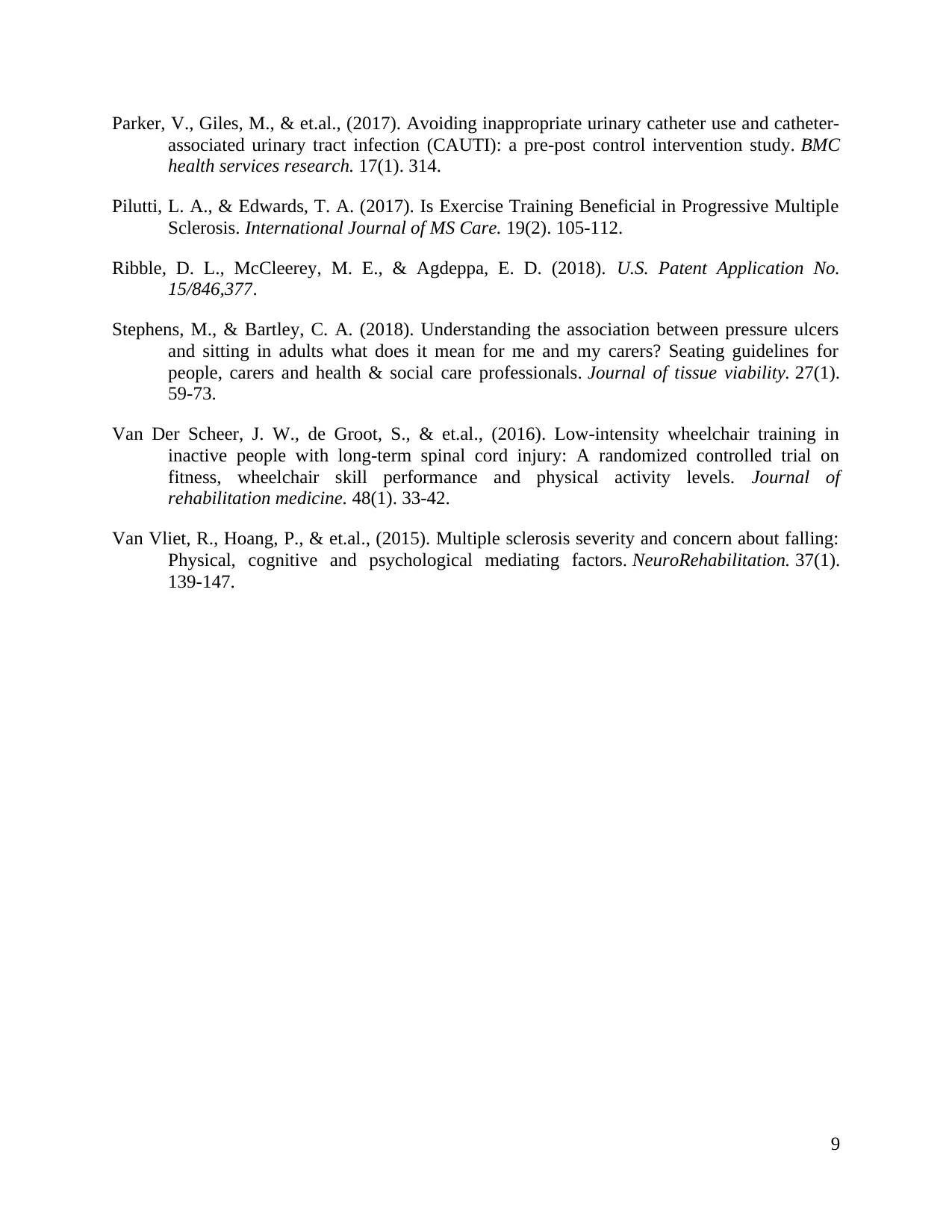
Parker, V., Giles, M., & et.al., (2017). Avoiding inappropriate urinary catheter use and catheter-
associated urinary tract infection (CAUTI): a pre-post control intervention study. BMC
health services research. 17(1). 314.
Pilutti, L. A., & Edwards, T. A. (2017). Is Exercise Training Beneficial in Progressive Multiple
Sclerosis. International Journal of MS Care. 19(2). 105-112.
Ribble, D. L., McCleerey, M. E., & Agdeppa, E. D. (2018). U.S. Patent Application No.
15/846,377.
Stephens, M., & Bartley, C. A. (2018). Understanding the association between pressure ulcers
and sitting in adults what does it mean for me and my carers? Seating guidelines for
people, carers and health & social care professionals. Journal of tissue viability. 27(1).
59-73.
Van Der Scheer, J. W., de Groot, S., & et.al., (2016). Low-intensity wheelchair training in
inactive people with long-term spinal cord injury: A randomized controlled trial on
fitness, wheelchair skill performance and physical activity levels. Journal of
rehabilitation medicine. 48(1). 33-42.
Van Vliet, R., Hoang, P., & et.al., (2015). Multiple sclerosis severity and concern about falling:
Physical, cognitive and psychological mediating factors. NeuroRehabilitation. 37(1).
139-147.
9
associated urinary tract infection (CAUTI): a pre-post control intervention study. BMC
health services research. 17(1). 314.
Pilutti, L. A., & Edwards, T. A. (2017). Is Exercise Training Beneficial in Progressive Multiple
Sclerosis. International Journal of MS Care. 19(2). 105-112.
Ribble, D. L., McCleerey, M. E., & Agdeppa, E. D. (2018). U.S. Patent Application No.
15/846,377.
Stephens, M., & Bartley, C. A. (2018). Understanding the association between pressure ulcers
and sitting in adults what does it mean for me and my carers? Seating guidelines for
people, carers and health & social care professionals. Journal of tissue viability. 27(1).
59-73.
Van Der Scheer, J. W., de Groot, S., & et.al., (2016). Low-intensity wheelchair training in
inactive people with long-term spinal cord injury: A randomized controlled trial on
fitness, wheelchair skill performance and physical activity levels. Journal of
rehabilitation medicine. 48(1). 33-42.
Van Vliet, R., Hoang, P., & et.al., (2015). Multiple sclerosis severity and concern about falling:
Physical, cognitive and psychological mediating factors. NeuroRehabilitation. 37(1).
139-147.
9
1 out of 11
Related Documents
Your All-in-One AI-Powered Toolkit for Academic Success.
+13062052269
info@desklib.com
Available 24*7 on WhatsApp / Email
![[object Object]](/_next/static/media/star-bottom.7253800d.svg)
Unlock your academic potential
Copyright © 2020–2025 A2Z Services. All Rights Reserved. Developed and managed by ZUCOL.




